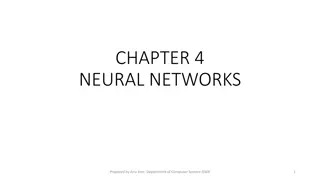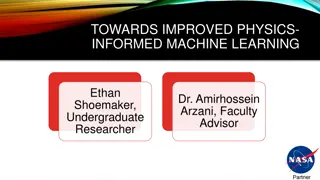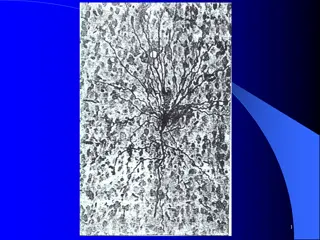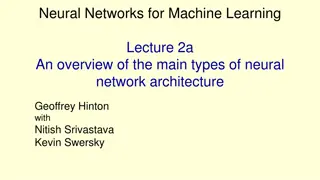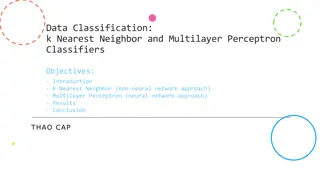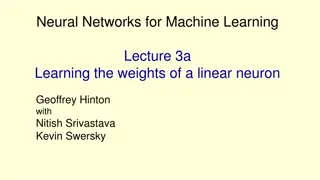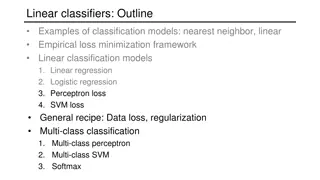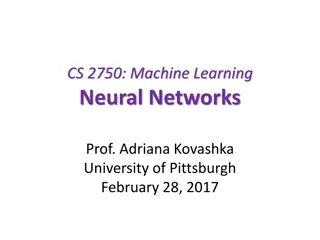Understanding Artificial Neural Networks (ANN) and Perceptron in Machine Learning
Artificial Neural Networks (ANN) are a key component of machine learning, used for tasks like image recognition and natural language processing. The Perceptron model is a building block of ANNs, learning from data to make predictions. The LMS/Delta Rule is utilized to adjust model parameters during training. Challenges like linear separability are addressed through multi-layer networks and techniques like Stochastic Gradient Descent. Explore the intricacies of ANN to unlock their potential in solving complex problems.
Download Presentation

Please find below an Image/Link to download the presentation.
The content on the website is provided AS IS for your information and personal use only. It may not be sold, licensed, or shared on other websites without obtaining consent from the author. Download presentation by click this link. If you encounter any issues during the download, it is possible that the publisher has removed the file from their server.
E N D
Presentation Transcript
Artificial Neural Networks
What are Artificial Neural Networks (ANN)? "Colored neural network" by Glosser.ca - Own work, Derivative of File:Artificial neural network.svg. Licensed under CC BY- SA 3.0 via Commons - https://commons.wikimedia.org/wiki/File:Colored_neural_network.svg#/media/File:Colored_neural_network.svg
Why ANN? Nature of target function is unknown. Interpretability of function is not important. Slow training time is ok.
LMS / Delta Rule for Learning a Perceptron model Need to learn the w parameter for a given problem. Delta rule is not the perceptron rule. Perceptron rule is rarely used now a days. This is gradient descent. ? 1 2 ??= 2? ?? ?? ?=1 Loss Function
LMS / Delta Rule for Learning a Perceptron model Initialize w to small random values Repeat until satisfied ? ???? =? ?? ? ?=? ??( ??) ? ? ????? Learning rate
Demo of Simple Synthetic Dataset Convex problem! Guaranteed convergence!
Problems with Perceptron ANN Only works for linearly separable data. Solution? multi layer Very large terabyte dataset. A single gradient computation will take days Solution? Stochastic Gradient Descent
Stochastic Gradient Descent (SGD) Approximate the gradient with a small number of examples may be just 1 data point. ? 1 2 ??= 2? ?? ?? ?=1 Can prove it is arbitrarily close to the true gradient for small enough learning rate. Try modifying the demo code at home to implement SGD.
Non-Linear Decision Boundary? Derivative of sigmoid?
Questions about the Sigmoid Unit? How do we connect the neurons? For this lesson, linear chain multilayer feedforward. Input Layer 1 Layer 2 Outside this lesson:- Pretty much anything you like How do we train? Backpropagation algorithm
Backpropagation Algorithm ? Each layer does two things Compute the derivative of E w.r.t. its parameters. Why? ?1= ?1? ?2= ? ?1 Compute the derivative of E w.r.t. its input. The reason for this will be obvious when we do it. ?3= ?3?2 ?4= ? ?3 ? =1 2 2? ?4
Dealing with Vector Data ? Partial derivatives change to gradients. ?1= ?1? ?2= ? ?1 Scalar multiplication changes to vector matrix products or sometimes even tensor vector products. ?3= ?3?2 ?4= ? ?3 ? =1 2 2 ? ?4
Problems Sigmoid units many of them vanishing gradients ReLU units, pretraining using unsupervised learning. Local optimum non convex problem Momentum, SGD, small weights for initialization Overfitting Use validation data for early stopping, weight decay. Lots of parameter tuning Use several thousand computers to try several parameters and pick the best. Lack of Interpretability
Demo on Face Pose Estimation Input representation Downsample image and divide by 255. Output representation 1 of 4 encoding Let s see the code Other learning parameters Learning rate 0.3, momentum 0 Single sample SGD.
Demo on Face Pose Estimation Layer 1 weights Layer 2 weights Right Up Left Straight
Expressive Power Two layers of sigmoid units any Boolean function. Two layer network with sigmoid units in the hidden layer and (unthresholded) linear units in the output layer - Any bounded continuous function. (Cybenko 1989, Hornik et. al. 1989) A network of three layers, where the output layer again has linear units - Any function. (Cybenko 1988). So multi layer Sigmoid Units are the ultimate supervised learning thing - right? Nope
Deep Learning Sigmoid ANNs need to be very fat. Instead we can go deep and thin. But then we have vanishing gradients! Use ReLUs.
Still too Many Parameters 1 Megapixel image over 1000 categories. A single layer network will itself need 1 billion parameters. Convolutional Neural Networks help us scale to large images with very few parameters.
Convolutional Neural Network AlexNet: ImageNet classification challenge ILSVRC 2012 winner
Benefits of CNNs The number of weights is now much less than 1 million for a 1 mega pixel image. The small number of weights can use different parts of the image as training data. Thus we have several orders of magnitude more data to train the fewer number of weights. We can get translation invariance for free. Fewer parameters take less memory and thus all the computations can be carried out in memory in a GPU or across multiple processors.
CNN toolboxes MatConvNet matlab; based focussing primarily on 2D images. Tensorflow python; supports a wide variety of neural networks. Torch lua (pytorch for python); supports a lot of things but not very popular for computer vision. Caffe De-facto framework for image classification like problems. lots of others (mxnet, theano, lasagna, keras).
Thank you Feel free to email me your questions at aravindh.mahendran@new.ox.ac.uk Strongly recommend this book for basics
References Cybenko 1989 - https://www.dartmouth.edu/~gvc/Cybenko_MCSS.pdf Cybenko 1988 Continuous Valued Neural Networks with two Hidden Layers are Sufficient (Technical Report), Department of Computer Science, Tufts University, Medford, MA Fukushima 1980 - http://www.cs.princeton.edu/courses/archive/spr08/cos598B/Readings/Fukushi ma1980.pdf Hinton 2006 - http://www.cs.toronto.edu/~fritz/absps/ncfast.pdf Hornick et. al. 1989 - http://www.sciencedirect.com/science/article/pii/0893608089900208 Krizhevsky et. al. 2012 - http://papers.nips.cc/paper/4824-imagenet- classification-with-deep-convolutional-neural-networks.pdf Lecun 1998 - http://yann.lecun.com/exdb/publis/pdf/lecun-98.pdf Tom Mitchell, Machine Learning, 1997 "MatConvNet - Convolutional Neural Networks for MATLAB", A. Vedaldi and K. Lenc, Proc. of the ACM Int. Conf. on Multimedia, 2015.




